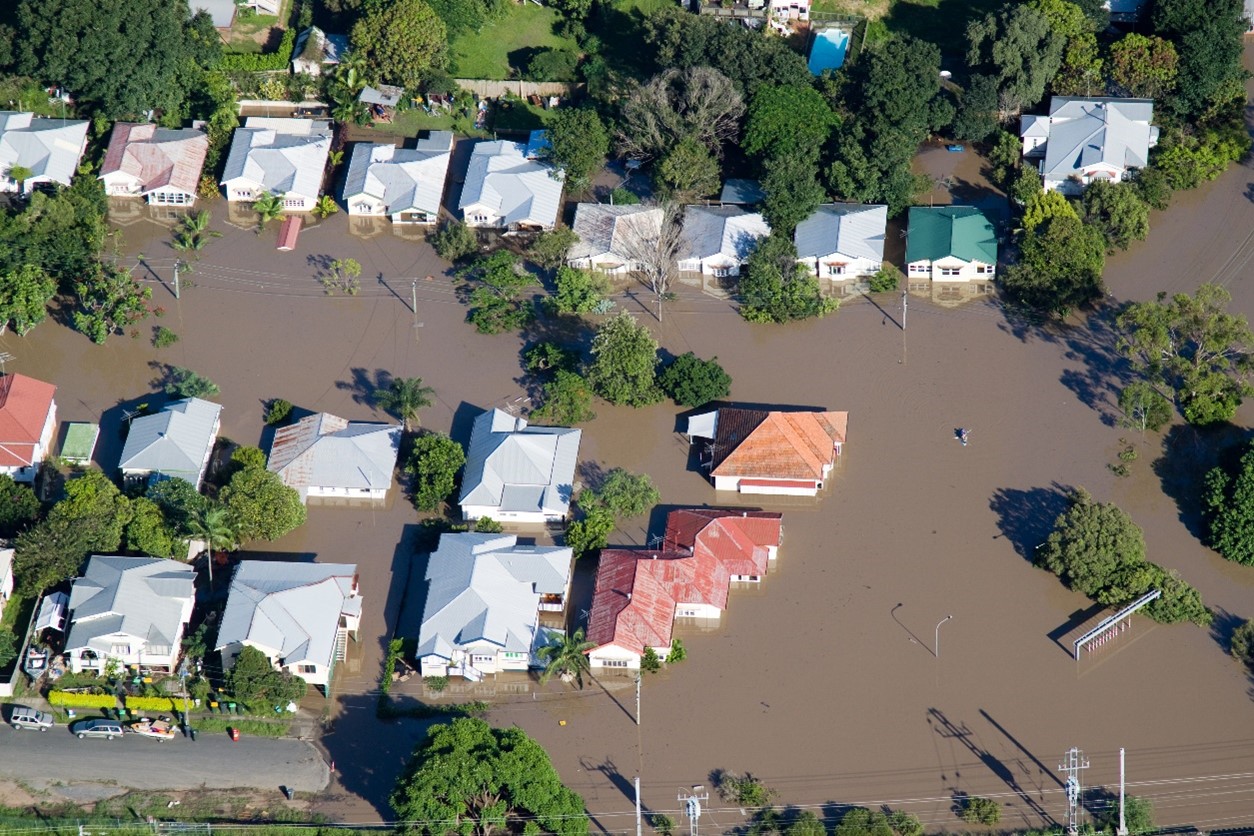Protecting Real Estate From Climate Risks
Highlights
- It is substantially economically beneficial to invest in climate change adaption now than to do nothing and face the unmitigated consequences on real estate assets of climate events.
- An effective climate mitigation action plan requires concerted action from all of a real estate manager’s teams, plus buildings’ managers and tenants.
- Efforts to mitigate climate change are evolving. Scientists are being drawn to this area of expertise and knowledge of climate change is improving fast, so data, analysis and tools can be updated frequently.
The effort, however, can reap dividends. “We estimate that one euro spent today saves four euros later on,” says Thierry Laquitaine, director of SRI at AEW, a global real estate management company.
Entering uncharted territory
AEW, an affiliate of Natixis Investment Managers, first started work on climate risk in 2016, when France’s Article 173 created mandatory carbon reporting for institutional investors.
As it mapped its properties it quickly realised that simply reporting on their carbon impact would not be sufficient. “We couldn’t just report the risks once a year, we really needed to try to reduce them,” says Laquitaine.
After scouring the market for a third-party solution, AEW realised a ready-made approach was not yet available. So it worked with a climate data provider to develop its own process for precisely detailing the risks of each of its assets. The newly-formed partnership visited AEW-owned buildings to evaluate their construction, their uses, their local environment and which equipment was deployed both in the maintenance of the building and by its tenants.
Armed with this data map, it was possible to forecast the overall vulnerability of a building to different climate hazards. After that, recommendations could be made to reduce the potential climate impacts, alongside a budget for improvements.
Taken together, the recommendations form an action plan, the blueprint for which could be rolled out to other real estate assets.
AEW’s pilot study focused on ten of its buildings in different regions of Europe and in different sectors – including residential, logistics, leisure and offices.
The study sought to quantify the difference in outcome if AEW a) did nothing and allowed the assets to be impacted by the full force of climate risks, or b) implemented a comprehensive action plan to mitigate climate effects.
“The outcome of the modelling was very clear,” says Laquitaine. “It is substantially economically better to invest now than to wait and do nothing and face the unmitigated consequences.”
Applying a climate risk action plan
Following the pilot, AEW proposed it should apply the action plan to all its investments. “Nearly 100% of our clients validated this proposal and for several years now we have included climate risks in the management of all our buildings,” says Laquitaine.
The process today begins at the due diligence stage, when AEW looks to acquire a building. If there are material climate risks, sufficient capex is incorporated into the business plan to adapt the building.
Existing assets are also screened to identify those buildings at most risk. Typically, a three- to five-year action plan is adopted to improve a building.
An effective action plan requires that all AEW teams are involved – including the investment and asset management teams and the technical departments.
Laquitaine says: “We have provided substantial training for our teams in different countries. Everyone must have sufficient knowledge to have right reflexes to address climate risks.”
Communication about each action plan extends to individual property managers, in order to, for example, establish procedures for warnings in the case of extreme climate events, and discuss operational issues such as the maintenance of air conditioning and other key equipment for tenants.
The impact of climate events
The growing prevalence of heatwaves globally have brought AEW’s mitigation measures into perspective. Heatwaves have only minimal impact on logistics assets, but a huge impact on residential buildings, shopping centres and some offices.
The key difficulty for residential property is at night-time, when cities which suffer from the “urban heat island effect”. Heat islands form as vegetation is replaced by the asphalt and concrete of roads and buildings, which absorb the sun’s heat, causing ambient temperatures to rise. This increases energy costs – particularly for air conditioning – and air pollution levels.
Most at risk are fragile populations such as those in senior housing. Heat-related illness and mortality rise as buildings absorb heat during the day and keep interiors hot at night. The temperature of buildings in central Paris, for instance, is 8C higher than in greener suburbs.
AEW runs thermal simulations and vulnerability assessments in residential buildings to define comfort inside during heatwaves. Recommendations can include installing reflective surfaces on the outside of buildings, the fitting of blinds, and more vegetation around buildings which helps reduce external temperatures and increase humidity.
Other climate-related risks include subsidence, which is linked to clay soils. If clay is subject to frequent drought and flooding, it expands and contracts leading to damage to the foundation and structure of buildings. “Subsidence is one of the main risks to buildings in Europe,” says Laquitaine. Most of the soil in France, the UK and Germany is clay, he notes.
Fluvial or sea submersion flooding risks are prevalent around Europe too, where the list is growing of towns and cities where the population will eventually have to move.

While flooding cannot be prevented on flood-prone land, asset managers can protect nerve centres of buildings such as the heating system, power-generation equipment and data storage. Certain rooms can be reinforced and critical equipment can be repositioned on higher floors, rather than in basements.
Evolution: improvements and partnerships
An action plan cannot be static. AEW works with third-party data providers to improve its tools in areas such as satellite imaging. AEW also works increasingly with public authorities and uses the action plans of some larger cities to inform its own analysis.
It also participates in real estate networks focusing on climate risk, such as the Sustainable Real Estate Observatory, an initiative of the real estate industry in France, which is currently leading a major climate change project.
Another initiative, led by AEW insurance team, aims to forecast what will happen to buildings and the financial impact on the insurance, in order to anticipate the risks and adapt the insurance scheme.
In other words, efforts to combat climate change continually evolve. “This is not a one-shot project,” says Laquitaine. “Our data, analysis and tools need to be updated frequently. Scientists are being drawn to this area of expertise and knowledge of climate change is improving fast. We all need to adapt our knowledge and keep pace with these changes.”
Published in June 2023
An affiliate of Natixis Investment Managers
Privately-held French "Société anonyme à conseil d’administration".
Real-estate investment manager under n°T 8324 delivered by the Prefecture de police de Paris.
Share capital: €17,025,900
RCS Paris: B 409 039 914
22 rue du Docteur Lancereaux 75008 Paris, France
www.aew.com
Natixis Investment Managers
RCS Paris 453 952 681
Share Capital: €178 251 690
43 avenue Pierre Mendès France
75013 Paris
www.im.natixis.com
This communication is for information only and is intended for investment service providers or other Professional Clients. The analyses and opinions referenced herein represent the subjective views of the author as referenced unless stated otherwise and are subject to change. There can be no guarantee that developments will transpire as may be forecasted in this material.
Copyright ©2023 Natixis Investment Managers S.A. – All rights reserved.





 Real Estate: Investors Seek Smarter ESG
Real Estate: Investors Seek Smarter ESG

 Climate-Informed Real Estate Returns in Europe
Climate-Informed Real Estate Returns in Europe
 Next-Generation Real Estate
Next-Generation Real Estate